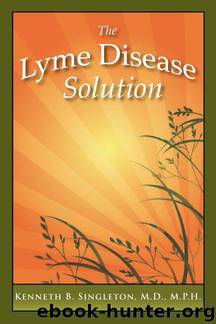The Lyme Disease Solution by Singleton Kenneth

Author:Singleton, Kenneth [Singleton, Kenneth]
Language: eng
Format: epub, mobi
Published: 2010-08-18T21:00:00+00:00
Types of Antibiotic Drugs for Treating Other Tick-Borne Diseases
What follows are the antibiotic treatments I have found to be most effective for treating the co-infections—the tick-borne diseases often coexisting with Lyme infection.
Bartonella/BLO There are two antibiotics that have been found to be most useful for treating Bartonella/BLO. My choice of these two antibiotics depends on two issues: (1) the extent to which the central nervous system (CNS) is affected and (2) the presence of co-infections other than Bartonella/BLO.
Levofloxacin (Levaquin). This antibiotic is generally considered to be the antibiotic of choice for the treatment of Bartonella/BLO. Levaquin is a member of the family of antibiotics known as fluoroquinolones, which also includes ciprofloxacin (Cipro). All the fluoroquinolones seem to have activity against Bartonella/BLO, but Levaquin seems to be the most effective. The dosage is 250-500 mg once a day. It is best to take Levaquin on an empty stomach (or with minimal food if you need to eat something due to gastrointestinal side effects). Also, it is important not to take minerals like calcium, zinc, iron, and magnesium within several hours of the dose of Levaquin, because these minerals will bind Levaquin and render it less effective. I advise that patients take levofloxacin early in the morning, or it can be taken late in the evening, but not at bedtime. Except for the tetracycline antibiotic group, the fluoroquinolones are not generally used in combination with other antibiotics. Usually the course of treatment for Bartonella/BLO is one to three months, but occasionally it may take much longer.
Precautions: Levaquin is usually very well tolerated. The major adverse reaction that may occur with use of this medication is tendonitis (inflammation of the tendons). This complication is not common, but when it occurs, the medication must be stopped for a few days to allow symptoms to resolve. It can then be restarted in a few days at a lower dose, but if the tendonitis recurs, the medication should be stopped. The mechanism for tendonitis is not clearly known, but magnesium deficiency may play a role in some patients. For this reason, I recommend that Bartonella/BLO patients ideally take 600–1,000 mg of magnesium for two weeks before beginning Levaquin therapy. Once Levaquin is begun, the patient should continue the magnesium, being careful to take it three (or more) hours before or after the dose of Levaquin.
Rifampin. Rifampin is a very old antibiotic that for many years has been used for the treatment of chronic infections such as tuberculosis. It is very effective against Bartonella/BLO. In particular, it is very useful for the neurological and psychiatric manifestations of Bartonella/BLO—severe anxiety and mood swings, panic, seizure-like episodes, memory loss, “spaciness,” confusion, disorientation episodes, and many other symptoms. Expect a herx-like reaction during the first week or so; then significant progress often occurs during the second or third week on rifampin.
It is best used in combination with certain other antibiotics. Frequently, those combinations include rifampin with doxycycline or rifampin with clarithromycin. The combination of rifampin with doxycycline is especially helpful when a patient with Bartonella/BLO is also infected with either Ehrlichia or Lyme.
Download
The Lyme Disease Solution by Singleton Kenneth.mobi
This site does not store any files on its server. We only index and link to content provided by other sites. Please contact the content providers to delete copyright contents if any and email us, we'll remove relevant links or contents immediately.
Periodization Training for Sports by Tudor Bompa(8173)
Why We Sleep: Unlocking the Power of Sleep and Dreams by Matthew Walker(6620)
Paper Towns by Green John(5092)
The Immortal Life of Henrietta Lacks by Rebecca Skloot(4528)
The Sports Rules Book by Human Kinetics(4299)
Dynamic Alignment Through Imagery by Eric Franklin(4119)
ACSM's Complete Guide to Fitness & Health by ACSM(3991)
Kaplan MCAT Organic Chemistry Review: Created for MCAT 2015 (Kaplan Test Prep) by Kaplan(3940)
Introduction to Kinesiology by Shirl J. Hoffman(3726)
Livewired by David Eagleman(3686)
The Death of the Heart by Elizabeth Bowen(3554)
The River of Consciousness by Oliver Sacks(3543)
Alchemy and Alchemists by C. J. S. Thompson(3452)
Bad Pharma by Ben Goldacre(3358)
Descartes' Error by Antonio Damasio(3232)
The Emperor of All Maladies: A Biography of Cancer by Siddhartha Mukherjee(3070)
The Gene: An Intimate History by Siddhartha Mukherjee(3050)
The Fate of Rome: Climate, Disease, and the End of an Empire (The Princeton History of the Ancient World) by Kyle Harper(3007)
Kaplan MCAT Behavioral Sciences Review: Created for MCAT 2015 (Kaplan Test Prep) by Kaplan(2941)
